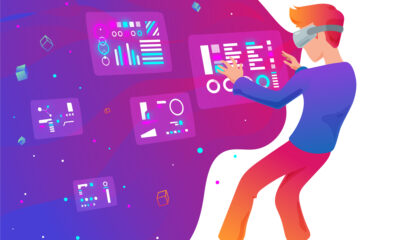Tech
Motives for the Growing Popularity of Web 3.0 Development

Over time, there have been substantial improvements and changes made to the internet. The development of the internet has been a wonderful trip from the early days of Web 1.0, when it was just a simple collection of static web pages, to the more dynamic online 2.0 period, where users could engage with the online and with each other through social media platforms. We are currently on the cusp of Web 3.0, a new internet era that is redefining corporate success. However, let’s first clarify what it is before going a little farther.
The next generation of the internet is known as Web 3.0.
Web 3.0 is frequently referred to as the decentralized web, where users can connect with applications in a more private and secure manner and have greater control over their data. Blockchain technology, a decentralized ledger that is irreversible and impermeable, is the foundation for Web 3.0 apps. As a result, Web 3.0 applications are not managed by a single body but rather by a network of computers that cooperate to keep the system’s integrity.
It can be stated more succinctly as follows: “Web 3.0 is about creating a more immersive and interactive web, where users can engage with content in new and dynamic ways.”
Web 1.0 to Web 2.0
In the early days of the internet, known as Web 1.0, most websites were static and lacked interactive features. Users were unable to engage with the content; they could only consume it. Most people utilized the internet to conduct research and obtain information. When Web 2.0 first appeared in the middle of the 2000s, it marked a significant shift in how people utilized the internet. Social networking, user-generated content, and interactive web applications were all introduced by Web 2.0. Users might engage with web apps, share material, and team up with others using Web 2.0.
Emergence of Web 3.0
Web 3.0 is the FUTURE and is completely changing how businesses operate now!
A number of reasons have contributed to the growth of Web 3.0. The growing understanding of the significance of data privacy and security is one of the most crucial causes. Numerous high-profile data breaches in recent years have exposed the personal information of millions of people. By giving people more control over their data through the use of blockchain technology, Web 3.0 aims to address these problems.
In 2023, the worldwide blockchain market is anticipated to be worth more than 6 billion dollars, according to a survey by Market Research Future. This suggests that Web 3.0 development has enormous growth potential.
Here is a picture that illustrates the point even more. Look at this –
The Top 5 Benefits of Web 3.0
The decentralized web, also referred to as Web 3.0, is an advancement of the present web (Web 2.0), and it is expected to bring about a number of advantages, such as:
- Decentralization: Web 3.0 is distinguished by decentralization, which suggests that it is not under the jurisdiction of a single body. As a result, it is safer and less prone to hacking and data breaches.
- Data Privacy: Users have more control over their data with Web 3.0. A tamper-proof ledger called the blockchain is where data is kept. Users now have peace of mind knowing that their data is safe and untouchable.
- Transparency: Because all transactions are recorded on the blockchain, blockchain technology offers transparency. This encourages trust and transparency because users can observe every transaction that has ever occurred on the network.
- Interoperability: Web 3.0 applications can communicate with one another because they are interoperable. This entails that users can utilize various programs on the same network, improving the effectiveness of the setup.
- Smart Contracts: Smart contracts are self-executing contracts that automate the transfer of assets or data and are used by Web 3.0 apps. This increases system efficiency and lessens the need for middlemen.
Even while creating a Web 3.0 application can be difficult, with the appropriate Web3 Development Agency, it can also be thrilling and gratifying. In order to create successful apps, developers must keep up with the most recent trends and technology in the quickly developing world of web 3.0 development.
Guide for Web 3.0 Development
Understanding the fundamental ideas behind decentralized applications (dApps) is the first step in creating a Web 3.0 application. Instead than being centralized on a single server like traditional programs, dApps are built on blockchain technology and are intended to be decentralized.
You must be familiar with the following ideas in order to create a Web 3.0 application:
Technology behind blockchain
Blockchain technology is the cornerstone of Web 3.0. It is a decentralized, digital ledger that safeguards and makes data accessible.
Sensible contracts
They are self-executing contracts that make use of blockchain technology and automate the verification, execution, and enforcement of contract conditions.
Interoperability
Applications for the Web 3.0 platform are created to be interoperable, which allows for data sharing and communication. This procedure is made easier by open standards and protocols.
Distributed Storage
In contrast to conventional centralized storage, Web 3.0 applications store data in a decentralized network, which offers higher security and privacy.
Tools
A professional web 3.0 developer, as well as a unique collection of tools and technologies, are needed to create a Web 3.0 application. Let’s learn more about a few of them:
- Blockchain – There are many blockchain systems that allow the development of decentralized applications (dApps) using smart contracts.
- Solidity is a computer language comparable to JavaScript that facilitates the development of smart contracts on the Ethereum network. It is typically thought to be simple to learn.
- The IPFS (InterPlanetary File System) is a peer-to-peer network-based decentralized file storage system that enables developers to store and retrieve data.
- The development framework truffle makes it simple to create, test, and launch dApps on the Ethereum network.
- Remix – The Ethereum platform’s Remix is a web-based development environment for creating and testing smart contracts. For creating and deploying smart contracts, it offers a user-friendly interface.
Spend money on Web 3.0 development to hasten the transition to the evolving web.
The prospects for web 3 appear bright. The subject of Web 3.0 development is expanding quickly, and it presents many potential for developers to create cutting-edge, decentralized apps. Building a Web 3.0 application may be a fun and gratifying process with the appropriate Web3 Development Agency. The development of Web 3.0 has a promising future as the need for secure, decentralized apps grows.
To produce safe, scalable, and decentralized apps, a leading provider of Web 3.0 development solutions, uses the newest blockchain technologies. Our skilled team of developers can provide tailored solutions that are tailored to your unique company requirements.
We can help you create any type of Web 3.0 application, including a decentralized identification system or a platform for decentralized finance. To find out more about our Web3 development firm and how we can help you realize your ideas, get in touch with us right away.
-
Blog1 year ago
MyCSULB: Login to CSULB Student and Employee Portal – MyCSULB 2023
-
Android App3 years ago
Cqatest App What is It
-
Android1 year ago
What Is content://com.android.browser.home/ All About in 2023? Set Up content com android browser home
-
Software2 years ago
A Guide For Better Cybersecurity & Data Protection For Your Devices
-
Latest News2 years ago
Soap2day Similar Sites And Alternatives To Watch Free Movies
-
Android2 years ago
What is OMACP And How To Remove It? Easy Guide OMACP 2022
-
Android3 years ago
What is org.codeaurora.snapcam?
-
Business2 years ago
Know Your Business (KYB) Process – Critical Component For Partnerships

























